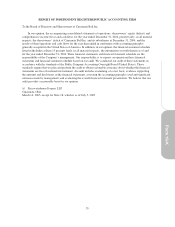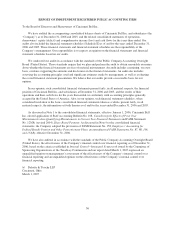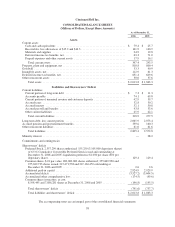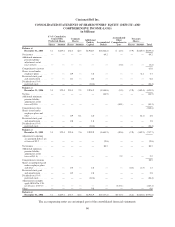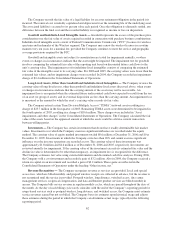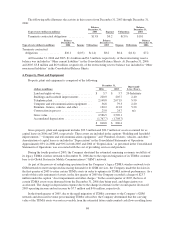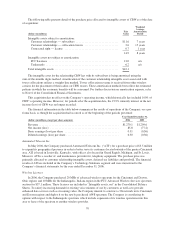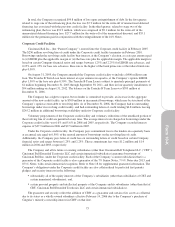Cincinnati Bell 2006 Annual Report Download - page 175
Download and view the complete annual report
Please find page 175 of the 2006 Cincinnati Bell annual report below. You can navigate through the pages in the report by either clicking on the pages listed below, or by using the keyword search tool below to find specific information within the annual report.
accrual of a contingent liability in prior years. Historically, the Company has evaluated uncorrected differences
utilizing the rollover approach. The Company believes the impact of not recording the operating taxes was not
material to prior fiscal years under the rollover method. However, under SAB 108, adopted in 2006, the
Company must assess materiality using both the rollover method and the iron-curtain method, which resulted in
the $9.0 million adjustment to opening retained earnings.
The expense from the cumulative error arose from the following periods:
(dollars in millions) 2005 2004 Prior to 2004
Expense adjustment before income taxes ................. $5.3 $3.1 $5.8
Expense adjustment after income taxes .................. $3.3 $2.0 $3.7
The after-tax amounts for 2006 associated with the first three quarters of the year were $0.9 million in the
first quarter, $0.9 million in the second quarter, and $0.6 million in the third quarter, and have been determined to
be immaterial to those quarters. Accordingly, the entire impact for 2006 has been recorded in the fourth quarter.
The Company believes it has meritorious defenses related to the payment of these operating taxes and
intends to defend its position in order to limit the ultimate payment of the fees.
Other Recently Issued Accounting Standards
In February 2006, the FASB issued Statement of Financial Accounting Standards No. 155, “Accounting for
Certain Hybrid Financial Instruments: an amendment of FASB Statements No. 133 and 140.” The objective of
the Statement is to simplify accounting for certain hybrid financial instruments, eliminate interim guidance in
Statement 133 Implementation Issue No. D1 “Application of Statement 133 to Beneficial Interests in Securitized
Financial Assets,” and eliminate a restriction on the passive derivative instruments that a qualifying special-
purpose entity may hold. This Statement is effective for all financial instruments acquired or issued after the
beginning of the entity’s first fiscal year that begins after September 15, 2006. Implementation of this Statement
is not expected to have a material impact on the Company’s financial statements.
In June 2006, the FASB ratified Emerging Issues Task Force Issue No. 06-3, “How Taxes Collected from
Customers and Remitted to Governmental Authorities Should Be Presented in the Income Statement” (“EITF
06-3”). This guidance requires that taxes imposed by a governmental authority on a revenue producing
transaction between a seller and a customer should be shown in the income statement on either a gross or net
basis, based on the entity’s accounting policy. This policy should be disclosed pursuant to Accounting Principles
Board Opinion No. 22, “Disclosure of Accounting Policies.” In addition, any such taxes that are reported on a
gross basis, if material, should be disclosed. EITF 06-3 will be effective for interim and annual reporting periods
beginning after December 15, 2006. Implementation of this Statement is not expected to have a material impact
on the Company’s financial statements.
In July 2006, the FASB issued FASB Interpretation No. 48, “Accounting for Uncertainty in Income Taxes
— an interpretation of FASB Statement No. 109” (“FIN 48”), which clarifies the accounting for income taxes by
prescribing the minimum recognition threshold as “more-likely-than-not” that a tax position must meet before
being recognized in the financial statements. FIN 48 also provides guidance on derecognition, classification,
interest and penalties, accounting for income taxes in interim periods, financial statement disclosure and
transition rules. Under this Interpretation, a Company determines whether it is more likely than not that a tax
position will be sustained upon examination by respective taxing authorities, including resolution of any
litigation. A tax position that meets the more likely than not recognition threshold is measured to determine the
amount of benefit to recognize in the financial statements. The tax position is measured at the largest amount of
benefit that is more likely than not realized. The Company will be required to adopt the provisions of FIN 48
related to all of the Company’s tax positions in the fiscal year beginning January 1, 2007. The cumulative effect
of applying the provisions of the Interpretation will be reported as an adjustment to the opening balance of
retained earnings. The Company has not yet completed its evaluation of FIN 48.
In September 2006, FASB ratified Emerging Issues Task Force Issue No. 06-1, “Accounting for
Consideration Given by a Service Provider to Manufacturers or Resellers of Equipment Necessary for an
End-Customer to Receive Service from the Service Provider” (“EITF 06-1”). This guidance requires the
application of EITF 01-9, “Accounting for Consideration Given by a Vendor to a Customer” (“EITF 01-9”),
when consideration is given to a reseller or manufacturer for benefit to the service provider’s end customer. EITF
65


